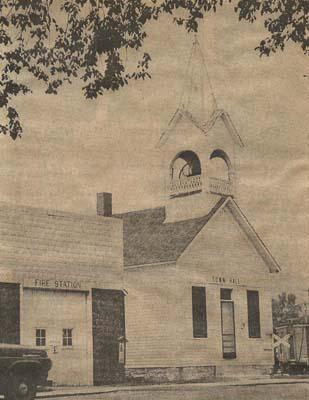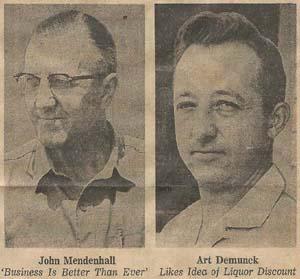updated 06/11/2017
![]()
updated 06/11/2017
Misc. New Albin History Articles |
New Albin Only Eight Years From
Reaching Century Mark
By Robert C. Gehl

Photo caption: Cornerstone -- New Albin could well be called a cornerstone of the State of Iowa, lying as it does in the northeast angle boundaries between Minnesota and Wisconsin. The view is looking northward, and the road that angles off to the left in the upper left hand corner is Iowa Highway 182, becoming Minnesota 26 when it crosses the border at the edge of town. Tribune Aerial Photo by Ed Huebner
This 92-year-old off-river community of 643 inhabitants is located in the northeast corner of the State of Iowa. The cast iron marker on the north ledge of the town designates the border between Iowa and Minnesota.
The town is situated on a plain at the mouth of a valley along Highway 182 about midway between Brownsville in Minnesota and Harpers Ferry in Iowa.
The highway is routed along the edge of the town but follows through one of the two main business streets.
A unique physical feature of the town is that while its two business streets parallel each other they are separated by a wide gulf through which the railroad runs.
The residential district lies almost entirely off one side of these business streets which are linked by several side streets.
New Albin is in a farming community and its business economy is largely dependent upon trade with the outlaying area.
The people are mostly of German and Irish origin and one of their outstanding characteristics is that most own their own homes.
About a dozen new homes have gone up since 1954.
About three-fourths of the workers in the town are employed by industries in La Crosse to the north and Lansing to the south.
Most of the men work in La Crosse and most of the women are employed in Lansing.
The present Highway 182 was constructed through here in 1936.
A rather remarkable story told here about the local citizenry is that 100 per cent of the voters turned out for the two most recent school elections.
And as many as 99 per cent of local eligible voters cast ballots in the last presidential election.
Mrs. Joseph (Margaret) Burke is now 92 and the town's oldest resident.
Ed Meyer is the person who has been in business the longest period of time.
Paul H. Meyer has served as treasurer of the fire department 36 years.
Largest industries in the village are the Lee Aluminum Foundry and Manufacturing Co., owned by Leon Hosch, which manufactures ,toy farm machinery and custom aluminum castings, and the John C. Mendenhall Lumber Co. which also produces cement blocks and silo materials. Hosch Marine Sales is a division of Lee Aluminum and Manufacturing Co. here.
Albert G. Meyer operates a log and lumber company and sawmill. Robert Potter runs a cheese factory and locker plant. John Wiemerslage has the stockyards. Bernard Mauss operates a produce firm and hatchery.
Meyer and Co. store is operated by Pete Hartley while the two other stores are owned by Peter Mays and Edgar and Shirley Wuennecke.
Other businesses include Alfred Meyer, furniture and electrical appliances; Leo and Leonard Heiderscheit, auto sales, garage and service station; Alfred Tabatt, garage; Robert Bowman and Connie Mauss, feed stores; and Nick Router, blacksmith and wagon repair.
Clinton Dee has an implement firm, Leslie Dresselhauss, a hardware store; Jee Fink and Frank Heiderscheit, cafes; Victor Cremer, supper club; Henry Becker and Walter Breeser, barbershops; Myron Kranbeer, Arthur Demunk, Robert Plagge and Robert Kester have taverns; Walter Weymiller, radio and television service; and Emil Weymiller, Gerald Darling and Martin Schuttemeier have service stations. Raymond Sires has a bulk oil company.
Harold Riehm does general contracting and road construction while Robert Dresselhaus does excavating, grading, trench work and sewer digging. Edwin Meyer and Son are well drillers. Adolph Rudnick runs a roadside fruit stand. John and Lulu Schuldt have a ladies' and men's wear store.
An unusual business in the town is the Paulus Pohlman wormery where fishing worms are grown on a commercial scale.
New Albin Savings Bank remodeled its building in 1956. Paul H. Meyer is bank president.
~source: September 1963 LaCrosse Tribune Newspaper clipping
~scan of photo & transcription from Errin Wilker
~*~*~
VILLAGE KEEPS PACE, BOASTS FULL FACILITIES
The "Town of New Albin" was incorporated in 1895 and a succession of town fathers have since governed its citizens and charted the course toward providing necessary facilities and services.
The town board today is composed of Mayor John Mendenhall and Councilmen Vernon Darling, Earl Wohlers, Frank Weymiller, Raymond Sires and Gotlieb Bellon.
Officers are Peter Hartley, clerk; Albert Fruechte, treasurer; Ignatius Imhoff, assessor; Wilbur Mark, constable; and Norbert Protsman and Adolph Rudnick, justices.
The fire department was organized in 1916 with Gene Boltz the first chief. The department today is headed by Chief Gene Meyer and has 21 members, three trucks and a resuscitator.
There are two town parks; one in the center of the business district and the other in the residential area. The latter is equipped with picnic tables.
A modern town water supply system was built in 1925 and a sanitary sewer system was completed in 1954.
The entire town has been lighted with modern mercury vapor street lamps since 1962.
New Albin Elementary School was built in 1918 and belongs to the Eastern Allamakee School District with Eastern Allamakee High School at Lansing 12 miles away. A new auditorium was added to the local school about nine years ago. There are eight grades here.
Cleon Sires is postmaster in the town. Delbert Welper is clerk and Mrs. Lillian Sires assistant. Rural carriers are James Valesh and Herbert Zarwell.
Three churches in the town are St. Peter’s Church of Christ served by Rev. Clyde Lee; Grace: Methodist served by Rev. Ernest E. Nielsen; and St. Joseph’s Catholic served by Rev. Edgar Kolfenbach.
Glen Meyer is president of The Community Club, which beginning in 1960, spearheaded development of a new access road from the town to Minnesota Slough some two and one-fourth miles distant. Cooperating in the project have been the Army Reserve, county and state. The club has about 40 members. The project will be completed this fall.
Bud Protsman is commander of the 50 member Veterans of Foreign Wars Post and Mrs. Donald Schoh is president of the 42-member VFW Auxiliary.
~Source: La Crosse Tribune, La Crosse, WI, abt 1963
~contributed by Errin Wilker
~*~*~
Doing Well in Liquor Competition

Town hall and fire station in the Northeast Iowa town of New Albin, where business is reported good and population growing. Residents feared the town would die when the state liquor store was closed six years ago, but business is better now than it was then, says Mayor John Mendenhall
New Albin, IA—Six years ago the state liquor store here was closed despite the pleas of residents that keeping it open would "help keep our town alive." Now with three establishments serving liquor by the drink and a fourth serving beer, this community in the extreme northeast corner of Iowa is "doing very well."
"Business is very good," said Mayor John Mendenhall, 60, owner of the lumber yard and manufacturer of concrete blocks. "In fact, we're doing more business than when the liquor store was here," he added. "It really doesn't make too much difference to me because I don't drink myself. "But that liquor store wasn't our only 'industry.'"
New Albin had a population of 568 in 1958. In 1960 the census showed it had 643 residents. Mayor Mendenhall said the town now has 658 residents. The town's north border is the Minnesota state line. The Mississippi river used to be its eastern boundary with Wisconsin just across the river. But a million-dollar federal project helped straighten the river channel and now about 3 miles of low land and swamp area separates the town from the river.
Mendenhall said the town has the usual shopping places for food, clothing, hardware, etc., and also has an aluminum foundry which makes castings and toys, a sawmill, cheese factory, sausage makers, and a wormery where worms are farm-raised for sale to commercial fishermen.
Mendenhall has been mayor for 12 years and before that was a councilman for 22 years. He employs 14 persons in his lumber and concrete block firms. "I've been here 37 years and my business is better than it ever has been," Mendenhall said. "Of course I'd favor a discount for wholesale liquor buyers such as our three stores." "They feel the pinch of competition from Minnesota and Wisconsin. La Crosse is only 28 miles away."

L: John Mendenhall - R: Art Demunck
Art DeMunck, 33, owner of Art's Tavern, who operates the train depot during the day, commented to liquor by the drink. "It's better than when the state liquor store was here," DeMunck said. "But I sure wish we could get the discount for bulk buyers. We're hurt by paying retail prices for our liquor and by paying the 10 percent gross tax on sales of liquor." "I wish the tax could be cut to 5 percent. We sell bar whiskey for 30 cents a shot. (It sells for 45 to 50 cents a shot in Des Moines.) We charge 35 cents for a 3/4-ounce shot for name brand whiskey. "They charge 35 cents a shot for bar whisky in Minnesota and Wisconsin, but we try to be competitive."
A beer license costs $250 a year. In addition, the liquor places pay $500 a year for a liquor license, $50 for a cigarette license, $200 a year for dram shop insurance (coverage for accidents involving patrons) and $10 for bond, or more than $1,000 in licenses and fees.
The town has a 9 p.m. curfew for youngsters. Taverns must close at 1 a.m. daylight time. They are not open on Sundays.
The town's name is an indirect result of a Fourth of July tragedy in 1872. Albin Rhomberg, 11, his pockets filled with gunpowder, stumbled while jumping over a large bonfire. The boy was placed in a tub of molasses to salve his burns but died the next day. Residents voted to call the town "Rhomberg" but Albin's father wanted it named "Albin." At the time there was another town with that name, so this community was named New Albin.
~Source: Des Moines Sunday Register, July 12, 1964
~photo scans & transcription contributed by Errin Wilker
~*~*~